Stunning Ceilings and the finer architectural designs of centuries old Ranakpur Jain Temples near Kumbhalgarh & Udaipur cities of Rajasthan
When we were visiting Kumbhalgarh town of Rajasthan, we drove nearly 50 kms to see the famous Ranakpur Jain Temple. 50 kms may sound less, but the terrain is such that it may take almost two hours to reach and certainly depending upon your driving style. However, the route takes you through rural Rajasthan and is quite interesting to observe. And of course if you are travelling with interesting people, that makes all the difference. There is very specific purpose of today's blogpost. During our 8 days long Rajasthan trip, ceilings of Ranakpur temple impressed the travellingcamera most because of different reasons. Let's continue this Photo Journey and know more about Ranakpur Temples, it's beautiful ceilings and wonderful architecture.
 |
| Three-storied Ranakpur Jain Temple |
 |
| Symmetrical structure of the Chaturmukh temple |
There are no tickets for tourists, except for a Rs100 charge in case you want to click pictures inside the temple, using either your phone or camera. We left our mobiles in the car and only those who were serious about photography carried them inside.
Related Blogpost - Neelkanth Mahadev Temple inside KumbalGarh Fort, Rajasthan - One of the few active temples inside Second Longest Wall of the World
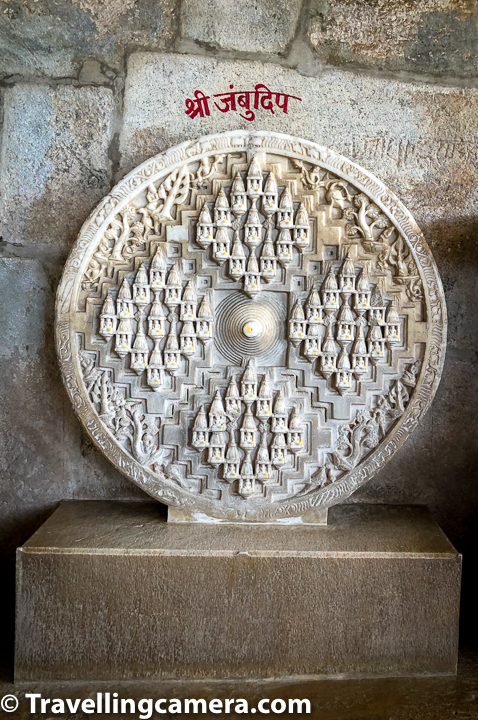 |
| Representation of Jambudweepa |
The main temple in the Ranakpur complex is the Chaturmukha temple, which is a stunning and massive marble structure. It is a Swetambara Jain temple dedicated to Rishabhadeva, the first Tirthankara of Jainism and the founder of the Ikshvaku dynasty. The temple was built in the 15th century and took 50 years to complete. Various sources differ about when the construction started and when it completed, but from the inscriptions on a copper plate dated 1436CE inside the temple, the construction commenced in 1389CE. Also the name of the architect who built the temple differs slightly in all the records. Some refer to him as Dwepa, some as Depaa, Depa, Depak.
Related Blogpost - Ranakpur Jain Temple in Pali District of Rajasthan || Gorgeous Architecture Inspired by a Divine Vision
Legend has it that Dharnashah, a Porwal from Ghanerao, saw the image of the mystical Nalini-Gulma Vimana in a divine vision. At that moment he knew that he wanted to build a temple in the image. Under the patronage of Rana Kumbha, after whom Ranakpur is named, he invited designs from artists. Several architects submitted their designs, but it was Dwepa's design that realized Dharnashah's vision to the fullest and was hired to build the temple. The process sounds very modern, doesn't it? Unfortunately Dharnashah did not live to see the construction of temple complete, but he was however able to establish the idols of Rishabhadeva inside the temple just before his death.
Related Blogpost - Sky scraping Jagdish Temple - A beautiful architectural wonder of Mewar Dynasty and a significant landmark inside Udaipur City of Rajasthan
 |
| Pujariji doubling up as a guide |
When we entered the temple, we were suitably awed by it, but were directionless. We did not know what we were looking at or should be looking for, so we requested the pujariji to explain it to us and It turned out to be the perfect decision. Pujariji was an awesome guide. He took us around the temple in a systemic way, educating us about the various idols and symbols and their meanings.
 |
| Elephant sculpture at the entrance |
In the Garbha of the temple (sanctum sanctorum) are the four statues of Rishabhadeva, each facing one of the four entrances to the temple. Domed ceilings of the four Meghanad Mandapas are intricately carved. The temple itself is a three-story structure and has innumerable pillars, lined perfectly and carved intricately.
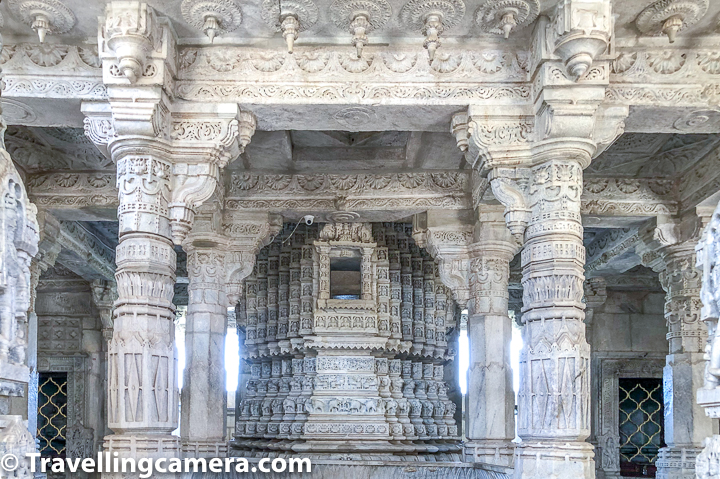 |
| Incomplete pillar |
It is said that there are 1444 pillars inside the temple, but it is also claimed that it is impossible to count the pillars. So you can choose what you want to believe or may be take on a mission to count the pillars. It is also said that none of the two pillars are alike. The reason for this is that there was no intention to make the pillars exactly alike and the artists were free to leave a mark of their individualities in their work. I liked this thought - templatization restricts creativity. Also there is one pillar that supposedly fell down every time it was built, because, as per the legend, the artist was egoistic and wanted a huge idol in his own image installed in the pillar. This pillar is still incomplete.
 |
| Innumerable Pillars |
There are several hidden symbols from Hinduism, Jainism, and Buddhism inside the temple - such as a representation of a leaf of Kalpavriksha, the wish-granting divine tree, the representation of Jambudwipa, the realm inhabited by mortal humans, and a representation of Parshvanath sheltered by 108 heads of snakes. The Parshvanath statue is carved out of a single marble slab and the tails of the snakes are intricately carved in infinity knots. As soon as you enter the temple, if you look up, you will see the statue of Kichaka with one head and 5 bodies representing the five elements.
 |
| Sculpture of Kichaka |
And carved into two pillars near two Meghanad Mandapas, facing the lord, are modest, barely noticeable statues of Dharna Shah and Dwepa, the visionary and the architect who have been immortalized by their magnificent creation. Pujariji also informed us that the descendants of the Dharna Shah still help manage the temple, the descendants of Dwepa still maintain and carry on repairs in the temple, and the descendants of the pujaris who had offered the first prayers inside the temple, still continue to serve in the same capacity.
 |
| Kalpavriksha Leaf |
Also a 400-year Rayan tree still stands and continues to flourish in the temple courtyard. You can also find Adinath's (Rishabhadeva's) foot idols under this tree. It is believed that it was under a Rayan tree that Lord Adinath delivered his first sermon.
 |
| 400-year old Rayan Tree |
Within the Ranakpur complex, there are several other temples that are definitely worth a visit. The entire area can easily be covered on foot. We also visited the Suparshvanath temple, which is famous for erotic carvings on its walls. I, however, didn't notice any such art. Two other temples in the complex were Sethi Ki Bari, which is another Swetambar temple, and a temple known as Chougan ka Mandir. About 500 metres from the main Ranakpur complex is the Sun Temple that is maintained by the Udaipur Royal Family Trust. This temple was built in the 13th century and then rebuilt in 15th century.
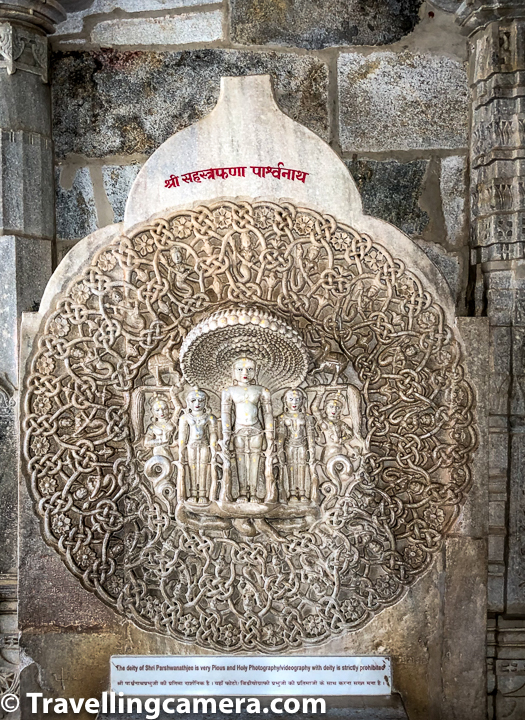 |
| Lord Parshvanath Sheltered by 108 snake heads |
In the 17th century, during Aurangzeb's era, Ranakpur became engulfed in war and was abandoned. The priests hid the idols before fleeing to prevent them from being destroyed by Mughal invaders. The area was reclaimed by wildlife and fell to ruins. In 19th century, a massive restoration drive was undertaken to reinstate the lost glory of the Ranakpur temples. The result of the restoration drive is there for everyone to see.
 |
| Serene surroundings |
By the time we completed the tour of the Ranakpur complex, we were quite hungry. There is a community eating place inside the Ranakpur complex that serves proper meals, but a quick tour inside the premises was enough to instill the fear of the pandemic in us and we skipped lunch. Instead we had some Rajasthani namkeens and buttermilk in the adjoining snacks shop.
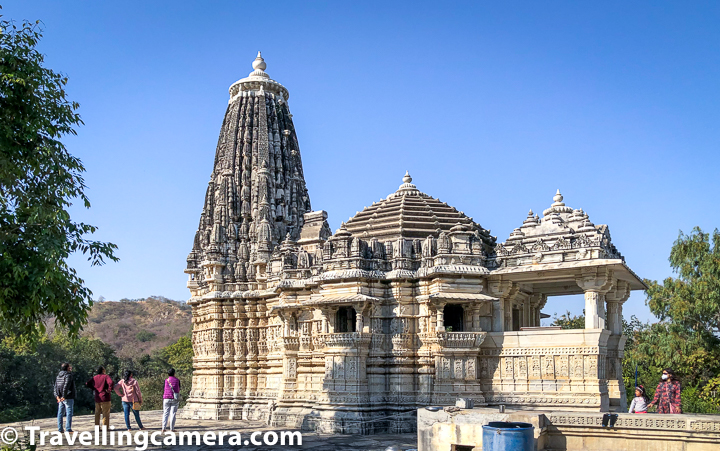 |
| Sun Temple |
This was another great place to visit during our Kumbhalgarh stay. The temples reminded me, only a little, of the temples in Ayutthaya, Thailand, and Angkor Wat, Cambodia. Of course the scale is very different, but they share a similar vibe. It may be because of the fact that all of these temples exist in perfect harmony with their natural surroundings and have a calming influence on visitors. There is a lot to explore here and you can spend hours just exploring and trying to interpret the various sculptures. Also, there are several birds around the temples, so enough material to keep the right kind of tourist interested for an entire day. Prepare for this trip accordingly.


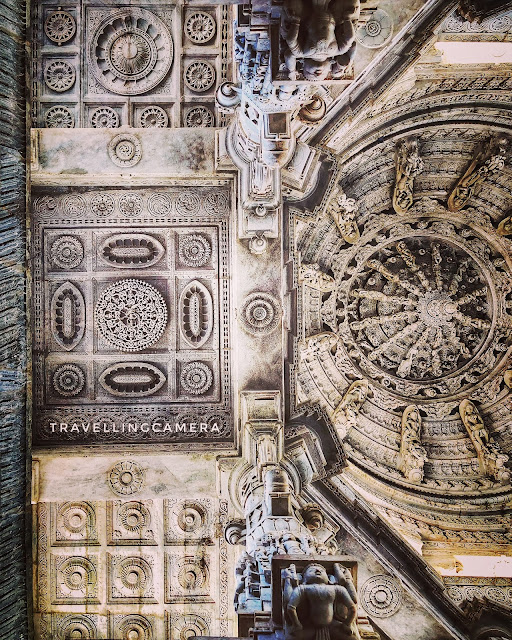
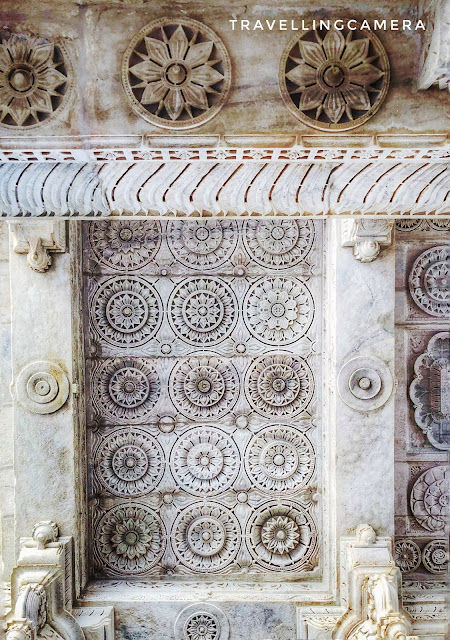
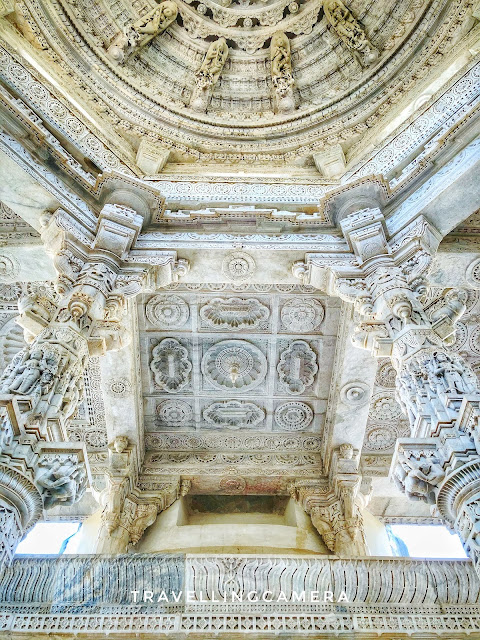
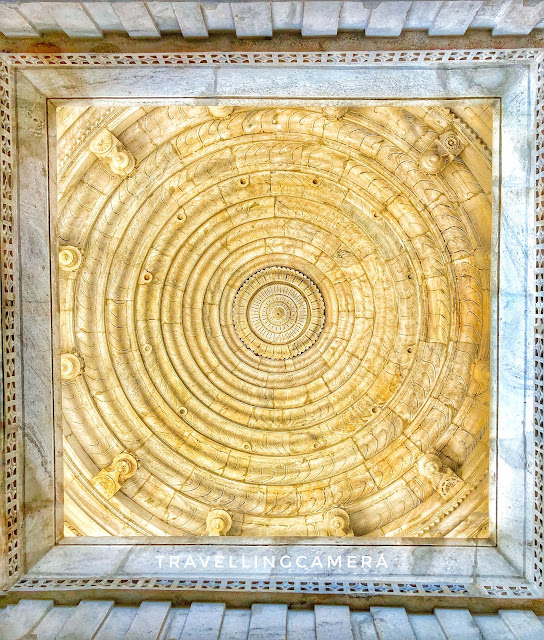



.jpg)
Comments